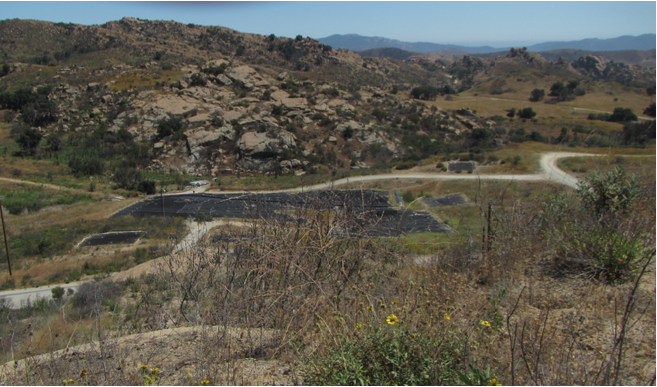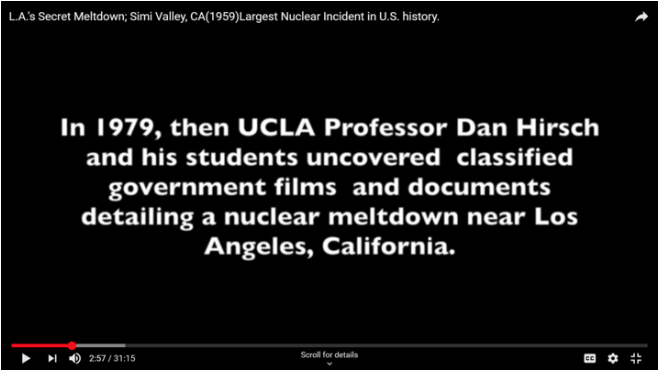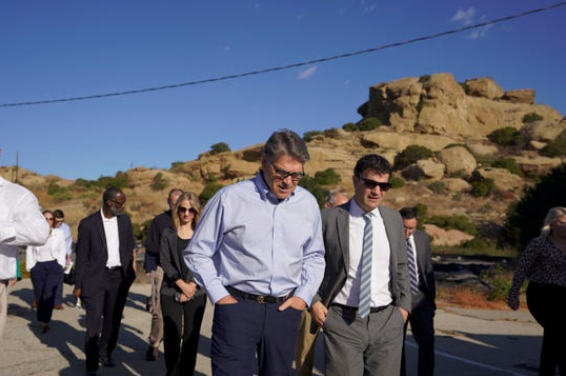CommentsTOXIC CONTAMINATION-This Thursday night, February 13, 2020, there will be a meeting of what is being called: the “SSFL Work Group.” I personally don’t think this term should be used because the “SSFL Workgroup” was an agency lead forum created by Charter on September 27, 1990 – almost 30 years ago this year.
(Photo credit – Bruce M. Rowe: Emeritus Professor of Anthropology - Los Angeles Pierce College. The Santa Susana Field Laboratory (July 17, 2019); Boeing Expert Storm Water Panel Field Trip)
The “SSFL Work Group” meeting this week is led by, according to their website: “Hosted by SSFL Work Group, Physicians for Social Responsibility- Los Angeles, Committee to Bridge the Gap, Rocketdyne Cleanup Coalition and Parents Against SSFL.”
Why is this important? This week, the SSFL Work Group is hosting the California Environmental Protection Agency’s (CAL EPA) Secretary Jared Blumenfeld. The title of this meeting is: “SSFL Cleanup Crisis: Finding a Path Forward”
- Why isn’t CAL EPA hosting their own event(s) on this topic?
- Why are the non-profits that are suing the State Agencies – the California Department of Toxic Substance Control (DTSC) which is under Secretary Blumenfeld’s leadership, and the California Department of Health (CDPH) able to hold a meeting on this topic when their litigation has, in my opinion, held up the cleanup since they filed suit in August 2013?
- Isn’t there a conflict here in a discussion with these non-profits who are suing these agencies when their Appeal documents are due to the 3rd Circuit Court of Appeals in California in March?
- Why hasn’t DTSC held any community meetings related to the Santa Susana Field Laboratory site since Gavin Newsom was elected as our Governor, and since Jared Blumenfeld was appointed CAL EPA Secretary?
- Is DTSC the agency understaffed or is it being gagged by management for some reason?
Without DTSC lead meetings on the Santa Susana Field Laboratory (SSFL), new stakeholders get their information from news sources and social media. And that information is frequently inaccurate to some degree.
This summer I got my first opportunity since the Woolsey Fire to visit the SSFL site with the Boeing Expert Storm Water Panel. The panel is a group of scientists and engineers who the Los Angeles Regional Water Quality Control Board (WaterBoard) appointed. The WaterBoard told The Boeing Company to fund the Expert Storm Water Panel back around 2008 for the purposes of advising the WaterBoard and the Responsible Parties – Boeing, NASA, and the Department of Energy, on how best to do remediation and to implement treatment strategies to protect against storm water runoff that is contaminated.
As the result of the Woolsey Fire in November 2018, parts of AREA I, AREA II, AREA III, the Southern Buffer Zone, and up to, but not including the structures of AREA IV, were burned, from what I was told. The tour and a presentation later that night by this panel in Calabasas showed what burned and what has been remediated to that date. We were able to see on that field trip with these experts what treatment had been done, and how the site had recovered in Boeing’s part of the property – primarily AREAs I and III. Their presentation in Calabasas can be found here.

Photo in AREA I of the Santa Susana Field Laboratory overlooking the AREA I Burn Pit – Photo Credit – Emeritus Professor Bruce M. Rowe
Why am I concerned that the SSFL Work Group is the venue for a discussion on the future of the SSFL cleanup? It is because, in my opinion, that this venue is where most people have been lead to believe the myths related to “meltdowns,” widespread radiation, offsite risk, and cancer clusters in my local community. These topics have been addressed historically at DTSC and other agency meetings in the last decade, and yet, the misinformation not only persists, but it is propagated by the very groups who are running this meeting.
It is my opinion that the members of these groups – “SSFL Work Group, Physicians for Social Responsibility- Los Angeles, Committee to Bridge the Gap, Rocketdyne Cleanup Coalition and Parents Against SSFL” have what is known as “Belief Perseverance”: “What Is Belief Perseverance? Definition and Examples”:
“Belief perseverance is the tendency to maintain one’s beliefs even in the face of evidence that contradicts them. We see this tendency with all kinds of beliefs, including those about the self and others, as well as beliefs about the way the world works, including prejudices and stereotypes.”
“Belief perseverance is the tendency to cling to one’s beliefs even when presented with information disproving them.”
One of these beliefs, in my opinion, is that a member of this group, Dan Hirsch, had the rank of Professor at UCLA, and in that capacity, he and his students uncovered a cover-up of a nuclear meltdown in 1959. The term Professor in the University of California academic system is a specific title that usually is earned after being an assistant professor and then an associate professor. The term “lecturer” is usually used for a part-time teacher. The use of the term “professor” in relationship to a university rank, implies full professor. This story about Dan Hirsch being a Professor at UCLA is perpetuated by a video that is on YouTube that has been seen more than 96,000 times:
“LA’s Secret Meltdown; Simi Valley, CA (1959) Largest Nuclear Incident in U.S. history.”

This screen shot is taken at the time shown from the movie linked above.
First, as far as I know, Dan Hirsch was never a Professor at UCLA. According to his signed application to teach a class at UCLA during Winter Quarter 1983 on “Energy Alternatives and Public Policy,” he was applying to teach in a special program called the “Council on Educational Development.” This special program had restrictions as to the number of classes that could be taught on a specific topic, and how frequently someone could teach in this program. His application to this program stated in 1979 that he had a degree from Harvard, his Major Subject was “Special Studies Modern Social Theory,” AB degree, magna cum laude in 1972. That application stated he taught from “1975 to Present in the Council on Educational Development, UCLA.” It states that he was a “Lecturer part-time, 1 quarter per year.” Has Mr. Hirsch completed any academic course work since he submitted this application to UCLA to teach?
In documents that have been circulated to Elected Officials and interested stakeholders regarding the WaterBoard, Mr. Hirsch has been addressed as “Dr. Hirsch.” And recently, at a meeting with NASA regarding their Supplemental Environmental Impact Statement, a stakeholder is heard shouting “Thank you Dr. Hirsch” as Mr. Hirsch is leaving.
Why is this important?
Mr. Hirsch is seen as the leader of the SSFL Work Group. His opinions on the future cleanup are held high by many stakeholders and the members of these groups sponsoring this event. Many of the people who are a part of this group believe that he is a scientist by academic training and a Professor.
A Call to Action:
I want to begin by thanking Congressmember Brad Sherman for holding hearings with our previous Energy Secretary Rick Perry regarding the Santa Susana Field Laboratory. I believe it was Congressmember Sherman’s desire for the Energy Secretary to not only tour the DOE’s portion of the SSFL site – which he did last year with CAL EPA Secretary Blumenfeld and a member of Congressmember Sherman’s staff. I believe that Congressmember Sherman wanted him to meet with the SSFL concerned stakeholders as well.

As described in the Ventura County Star, “U.S. Energy Secretary Rick Perry on Sept. 6, 2019 toured his department's portion of the contaminated Santa Susana Field Laboratory, which the agency is responsible for cleaning up. (Photo: CONTRIBUTED PHOTO:/U.S. DEPARTMENT OF ENERGY)”
Shortly after this SSFL site visit, Energy Secretary Perry resigned.
Since that site visit and his subsequent resignation, I have not heard any information related to the discussions between the DOE and the State of California about the future cleanup of the SSFL.
I would like to call upon Congressmember Sherman and other Congressmembers whose constituents are concerned regarding potential offsite risks to hold a Community Town Hall on the Santa Susana Field Laboratory. I would like their State counterparts in the State Senate and the Assembly to also be a part of this event as they have been for Aliso Canyon. We also need our County and City Representatives to attend this Town Hall. They need to invite not only Cal EPA Secretary Blumenfeld, but DTSC staff, CDPH staff, WaterBoard staff, and other independent experts who are not affiliated with the SSFL Workgroup.
We need our Elected Officials to ask the hard questions which I have referenced in previous articles.
- Was there a meltdown at the Santa Susana Field Laboratory?
- Was it the worst nuclear disaster in the history of the United States?
- Can you define what happened at that incident in 1959 at the Sodium Reactor Experiment?
- What was the previous cleanup standard for AREA IV of the SSFL?
- Is there any offsite risk? How far away from the SSFL site is there a risk?
- What are the results of the air monitoring data from the monitors around the SSFL site?
- Is there a regular water pathway to the community that poses a risk when there is not an event such a fire?
- How long will it take to clean up the SSFL site?
- Can the SSFL site be cleaned up safely without the removal of large volumes of soil from the SSFL site?
- When will the DTSC’s Final Programmatic Environmental Impact Report be released?
- What is the 2010 Administrative Order on Consent?
- If an agreement is signed and part of it is found to be unconstitutional, is that agreement void?
- Why did DTSC agree to clean up the SSFL site without a human health risk assessment?
- Do Boeing, NASA, and the DOE need to consider the cultural impacts to the SSFL site and the fact that the Santa Ynez Band of Chumash has declared that this whole site is Sacred Lands?
- Is signing a cleanup agreement before doing a CEQA or NEPA review pre-decisional under those laws?
A shout out to our elected officials: we need real scientific answers to our questions for the protection of the local residents today, and the local residents in the future.
(Chris Rowe has been a 41-year resident of West Hills, was a former West Hills Neighborhood Council Board Member, and has a B.S. in health education. She can be reached at [email protected].) Edited for CityWatch by Linda Abrams.
















